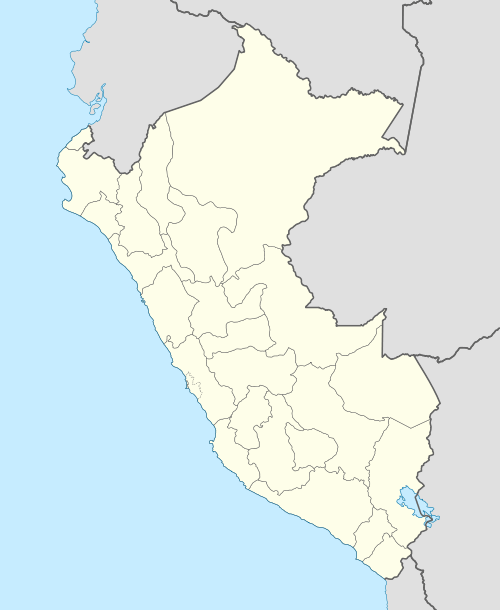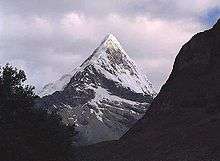Artesonraju
| Artesonraju | |
|---|---|
|
Artesonraju | |
| Highest point | |
| Elevation | 6,025 m (19,767 ft) [1] |
| Coordinates | 08°57′S 77°38′W / 8.950°S 77.633°WCoordinates: 08°57′S 77°38′W / 8.950°S 77.633°W |
| Geography | |
 Artesonraju Peru | |
| Location | Ancash, Peru |
| Parent range | Cordillera Blanca |
| Climbing | |
| First ascent | E. Hein, E. Schneider (August 19, 1932)[2] |
| Easiest route | Snow/ice climb |
Artesonraju[1][3][4][2] is a mountain peak located in the Cordillera Blanca mountain range in the Peruvian Andes. Its summit has an elevation of 6,025 metres (19,767 ft)[1] (or 5,999 metres (19,682 ft) according to the IGN-Peru map).[3] It is one of many prominent peaks located within the boundaries of Peru's Huascarán National Park.[4]
It has been suggested that Artesonraju is the mountain depicted in the live-action Paramount Pictures logo, its summit ringed with 22 stars.[5]
Climbing
There are two main climbing routes. The first one, rated AD+ according to the International French Adjectival System, runs along the north ridge from the Santa Cruz ravine (a terrific trek in itself) and it was the route used in 1932 by Erwin Hein ed Erwin Schneider of the Deutscher und Österreichischer Alpenverein for the first successful climb.[6]

The second crosses the southeast face. The approach begins in the city of Caraz at an altitude of 2,256 metres (7,402 ft), and from there proceeds upward another 2,000 meters along a 32-km dirt road to Lake Parón. A path along the lake's north shore brings climbers to the Base Camp at 4,250 metres (13,944 ft). It involves a trek from Parón lagoon to the base of the face of the mountain and then a long climb (10–12 hours return) from a camp at 5,000 metres (16,404 ft) where usually water is available.
This last route has been recently the standard route to the summit and it has become one of the classic Andean climbs.,[7] It demands good ice climbing technique, as there is a grade of about 50-55 degrees for well over 900 vertical meters, with some pitches at 60 degrees. At the end of the dry season a bergschrund can make problematic the last section of the climb. The route is rated D and was climbed the first time on the 24 June 1969 by K. Schreckenbach, H. Saler and K. Sussmilch.[8] A large number (and perhaps disproportionate when compared to the actual relative difficulty of the climb) of accidents have happened on this climb, mainly because the same route has to be used for the descent and all anchors have to be made on snow and ice and therefore might not give sufficient protection when abseilling.
The summit ridge of Artesonraju is well known for its fragility; special care must be taken as there is an unusually high risk of avalanches at the start of the climbing season here. For this reason many parties prefere to climb the southeast face, albeit this last route is more difficult.
A third route, particularly difficult and rated TD+, runs along the south ridge and is very rarely climbed. It was climbed the first time on the 24 June 1969 by a Yugoslavian party (T. Sbrizaj, S. Semraj and B. Naglic). Other routes have been climbed, but very rarely repeated.
During August, the windiest month, the peak tends to form a "wind shield", so extreme caution must be taken, especially if temperatures are below zero.
See also
References
- 1 2 3 Alpenvereinskarte 0/3a. Cordillera Blanca Nord (Peru). 1:100 000. Oesterreichischer Alpenverein. 2005. ISBN 3-928777-57-2.
- 1 2 "Artesonraju". www.montanasperuanas.com. Retrieved 2016-07-05.
- 1 2 Peru 1:100 000, Corongo (18-h). IGN (Instituto Geográfico Nacional - Perú).
- 1 2 "Nevado Artesonraju" (in Spanish). mincetur. Retrieved May 6, 2014.
- ↑ The Stories Behind Hollywood Studio Logos
- ↑ American Alpine Journal – 1941.
- ↑ "The Alpine Club of Canada – Jen Higgins Fund". Retrieved 9 October 2013.
- ↑ American Alpine Journal – 1970.
